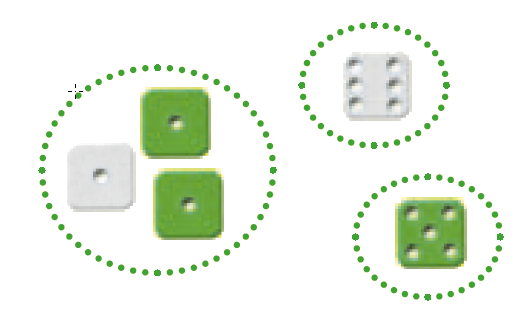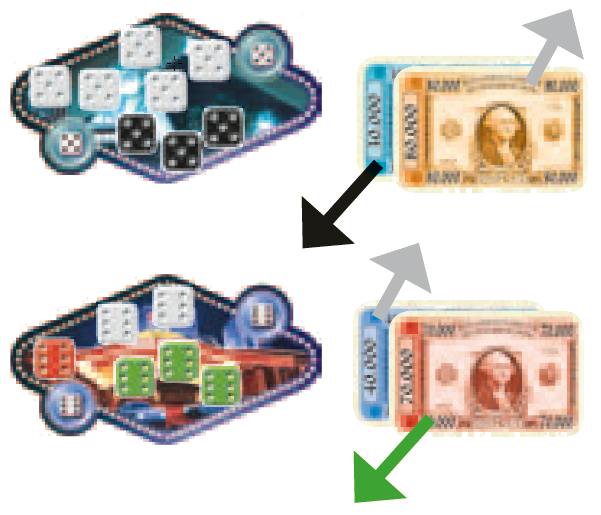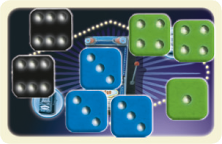If you are reading these rules for the first time, ignore the text along the right hand side. These rules serve as a summary to help you quickly familiarize yourself with the game.
Variants
Neutral Dice
All previous rules are in effect with the following exceptions:
At the start of each round, players receive, in addition to the 8 dice
in their colour, additional dice in a neutral, unused, colour
(we recommend white):
-
with 2 players, each player receives 4 white dice (= 12 total)
-
with 3 to 6 players each player receives 2 white dice (= 10 total)
(In a three player game, two additional white dice get rolled by
the start player at the start of the round and placed accordingly.)
On your turn, you must roll your neutral dice along with those of your
own colour and then place them just as you would your own.

Example:
Carla rolls two 1s of her own colour as well as one white 1; she also
rolls a 5 of her own and a neutral 6. She can now choose to place either all three 1s, her own 5, or the neutral 6.
At the end of a round, the neutral dice are scored as if they belonged
to an additional (imaginary) player. Any money that this ‚player‘ wins
gets added to the bottom of the pile.

Example 1:
The $80,000 note goes to white (and is thus added to the bottom of
the pile); Benno receives the $30,000 note.
Example 2:
Carla receives the $70,000 note and white receives the $40,000 note
(added to the bottom of the pile); Anna receives nothing.
.
Minimum amount
This summary shows the minimum amount of money that must
be placed beside each casino at the beginning of each round, based on
the number of players in the game.
- 2 players: 30,000$
- 3 players: 40,000$
- 4 players: 50,000$ (like basic game)
- 5 players: 60,000$
- 6 players: 70,000$
100,000$
5 100.000$ banknotes are shuffled together with all the other banknote cards.
Biggies
Biggies are bigger dice which are counted as two dice during scoring.
At the beginning of the game, each player replaces one regular die with
the matching biggie (so each player still uses 8 dice).
The biggie is rolled and placed together with the regular dice, as written
in the basic rules, but counts as two dice during scoring.
Kickers
Violet dice are used as "kickers"; they "kick out" dice already on a casino
back to a player’s supply.
At the beginning of the game, each player trades one regular die for one
kicker (so each player still uses 8 dice).
All unused violet dice are returned to the game box.
Note: If there are fewer than 6 players, each player should trade two regular dice for two kickers.
The kicker is rolled and placed together with the regular dice
according to the basic rules. When a kicker is placed on a casino, the
player removes the kicker and any one* die immediately, places the
kicker on the back of the summary card (where it is out of play for
the rest of the round), and gives the die that has been "kicked back"
to its original owner (who can use it again). Remember: kickers never stay on casinos!
Notes:
-
* Could include your or your opponent’s…"
-
A player without any dice left who has one "kicked back" is in the game again. This player could also use
an unplayed action card (see below) at this point.
-
When a kicker is used on an empty casino (or slot machine, see below), it has no effect. The kicker is
immediately moved to the display card.
Rainbow Cards
At the beginning of the game, the rainbow cards are shuffled with all
other banknotes. If a rainbow card is dealt to a casino during set-up, its
value is calculated as $40,000.
After all dice have been placed, and before scoring starts, each rainbow
card is placed in a discard pile and replaced with a new banknote from the
top of the draw pile.
If a new rainbow card is turned up, it is also discarded and replaced with a new card.
Slot Machine
The slot machine is treated as a seventh casino, using the same rules as
the other casinos, with the following three exceptions:
1. Dice placed on the slot machine can show any number, 1-6.
2. A player must place all dice of one number, but the number on the dice must be different
than the numbers already on the slot machine.
Anna has placed 4’s on the slot machine. No one else may place 4’s there, including Anna!
At the end of a round, the slot machine is scored as follows: The player with the most dice has
first choice of banknote, the player with the second most dice chooses second, and so on.
As with regular casinos, no player on the slot machine can win more than one banknote. Any
banknotes that are not won are placed face down at the bottom of the draw pile.
3. If 2 or more players have tied for the most dice placed on the slot machine, the winner is the
player whose dice have the highest sum. If the players’ dice have the same sum, the player
with the higher numbered die wins first choice.

Example:
Denny places three dice with the number 3 on the slot machine. No player
may place any more 3’s on the slot machine during this round (including Denny!).
Ben places two 6’s, and Carla places two 4’s. In a later turn Carla Carla adds one single 1.
When scoring, Carla has first choice, since her three dice shows the same sum as the
three dice of Denny (9), but Carla has placed the higher numbered die (4).
Denny chooses a banknote second, then finally Ben ...